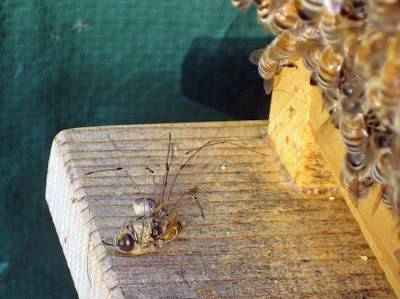You can feel the intensity of the shifting season at the hives; it rivals anything that came before, or it so it seems. Several species of goldenrod are giving nectar in abundance and the bees are working the blossoms like wild.
I took a walk deep into the gold and purple field yesterday afternoon. A beautiful, crisp autumnal day of shining sun. Apples red in the trees. Monarchs rising and falling on the currents of the breeze. The honeybees, it seemed, were everywhere. Dozens and dozens of them working every stand of goldenrod. A few working the white and purple asters, and one rugged individualist foraging the very last of the black knapweed. No detail overlooked, nothing going to waste.
With these final days of gathering in anticipation of the oncoming cold comes the inevitable time of consolidation for the colony: the eviction, the mass murder of the drones.
This morning, I was startled to see a bee drag a big white drone larva from the hive. I then noticed other drone larvae on the ground nearby. The bees are cleaning house—they know they won't need drones during the long, cold winter. Those honeycomb cells can be put to better use storing the food the workers and queen will depend on during the months of no flowers, the months of weather too cold to explore, scout, forage, fly.

The workers are also kicking out the adult drones. At this point, the unfortunate drones represent nothing more than freeloaders, consumers of nectar and honey so carefully stored in the hive to provide the hope of winter survival. The drones are a liability the colony can no longer afford. Here, a daddy longlegs consumes an evicted drone.

I'm fond of the bumbling, good-looking drones, and in my strong desire for stories with happy endings, I wish things could be another way. Fortunately, I'm not running the show here. Nature takes a bigger view and has imbued the honeybee with the immeasurable efficiency and practicality of the hive-mind. These creatures who spend their hours gathering sweet elixir from the flowers certainly cannot be accused of taking a sentimental view of life.
Here's a particularly good looking guy biting the dust.

And here's an action shot: a worker beating up on a drone. The worker is on the right, the drone is on his back—he's defenseless. He has no stinger and no hope of being allowed back inside. Before long, he will perish of cold or hunger or, perhaps, of a broken heart.

In The Life of the Bee, Maurice Maeterlinck writes vividly of the otherwise happy-go-lucky drones' response to "the massacre of the males":
"The great idle drones, asleep in unconscious groups on the melliferous walls, are rudely torn from their slumbers by an army of wrathful virgins. They wake, in pious wonder; they cannot believe their eyes; and their astonishment struggles through their sloth as a moonbeam through marshy water. They stare amazedly round them, convinced that they must be the victims of some terrible mistake; and the mother-idea of their life being first to assert itself in their dull brain, they take a step toward the vats of honey to seek comfort there. But ended for them are the days of May honey, the wine-flower of lime trees and fragrant ambrosia of thyme and sage, or marjoram and white clover. Where the path once lay open to the kindly, abundant reservoirs, that so invitingly offered their waxen and sugary mouths, there stands now a burning bush all alive with poisonous, bristling stings."

Hi, Gerry! It's John. How does the colony resupply itself with males in the spring? Are there dormant drone larvae that last through the winter?
ReplyDeleteHi, Anonymous John!
ReplyDeleteIt's all about the queen.
During the winter, it is only workers and the queen clustered together in the hive to stay warm.
During this time, the queen greatly slows or suspends her egg-laying. Then, in the spring, when the bees can once again forage for nectar and pollen (required for raising brood), her egg-laying activity increases.
At that time, she will lay both drone and worker eggs (drone about 10%, workers about 90%)--each in a differently sized comb. (Yes, the queen makes these determinations as she lays; worker eggs are fertilized, drone eggs unfertilized repro by parthenogenis, if I understand correctly. Honestly, honeybee reproduction is pretty complicated and I am still trying to understand the nuances.)
Combs with larger cells contain drone brood, since drones are bigger than workers. Combs with smaller cells contain worker brood, since workers are smaller. Incidentally, the larger combs are also used as honeycombs.
Hope this answers your question. See you soon!
GGP
Hello. I am trying to determine if my hive will make it thru the winter as is. Received bees at end of May, thought they were doing great, but now I can't determine if they are queen-less. Something doesn't seem right. Is it too late to requeen? It is almost Nov. and I live in Maryland.
ReplyDeleteI'm certainly no expert on beekeeping—still learning myself...What makes you think they're queenless? My sense is that it probably is late to re-queen, but if you have more than have colony, maybe you could combine your weak/queenless colony with a stronger one.
ReplyDelete